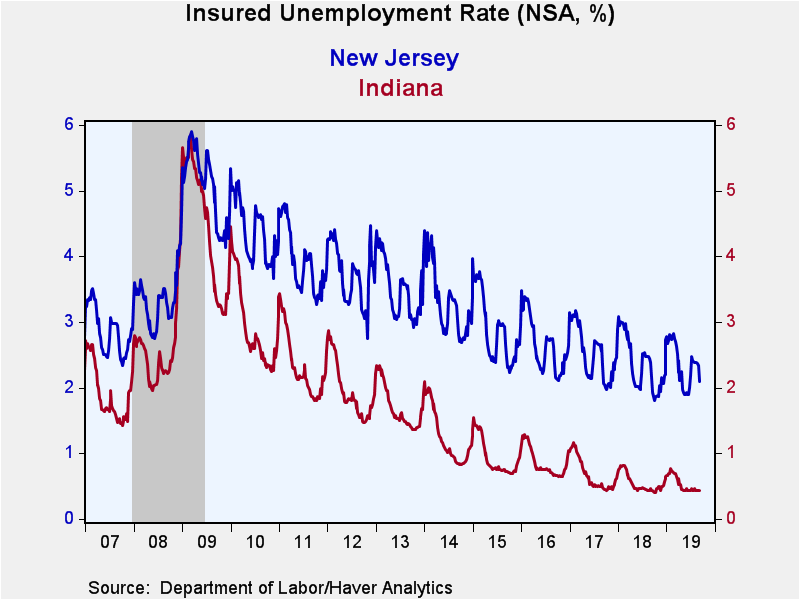 Global| Sep 26 2019
Global| Sep 26 2019U.S. Initial Claims for Unemployment Insurance Increase Slightly, Rate Hits New Low
Summary
Initial claims for unemployment insurance in the week ending September 21 increased 3,000 to 213,000 (+0.5% y/y) from 210,000 in the previous week, which was revised from 208,000. The Action Economics Forecast Survey expected 212,000. [...]
Initial claims for unemployment insurance in the week ending September 21 increased 3,000 to 213,000 (+0.5% y/y) from 210,000 in the previous week, which was revised from 208,000. The Action Economics Forecast Survey expected 212,000. The four-week moving average of initial claims, which smooths out week-to-week volatility, declined to 212,000 from 212,750.
Continuing claims for unemployment insurance fell 15,000 to 1.650 million (-1.9% y/y) in the week ending September 14 from 1.665 million in the prior week, upwardly revised from 1.661 million. The 1.650 million reading was the lowest since October 27, 2018. The four-week moving average of claimants declined to 1.666 million from 1.678 million.
The insured rate of unemployment for the week ending September 14 eased to 1.1% from the longstanding 1.2% rate where it has been since May 2018. While this is indeed a new low, the weekly change is actually very small, with the unrounded calculation of continuing claims versus “covered employment” moving from 1.155% the prior week to 1.144%. Data on the insured unemployment rate go back to 1971.
Insured rates of unemployment vary widely by state. During the week ending September 7, the lowest rates were in South Dakota (0.20%), Nebraska (0.31%), Utah (0.40%), North Dakota (0.41%) and Indiana (0.43%). The highest rates were in Alaska (1.47%), Pennsylvania (1.59%), Connecticut (1.62%), California (1.67%), and New Jersey (2.10%). Among the other largest states by population not mentioned above, the rate was 0.96% in Texas, 0.48% in Florida, and 1.28% in New York. These state data are not seasonally adjusted.
There are very preliminary “advance” data on initial claims by state, also not seasonally adjusted and slightly different by geographic coverage from the later data. However, these advance data do show an increase of 4,269 in Michigan and 1,487 in Kansas, both outsized weekly increases for those states reflecting the General Motors strike, which began September 15. Obviously, these will be updated in the next couple of weeks.
Data on weekly unemployment claims going back to 1967 are contained in Haver's WEEKLY database, and they are summarized monthly in USECON. Data for individual states are in REGIONW. The expectations figure is from the Action Economics Forecast Survey, carried in the AS1REPNA database.
| Unemployment Insurance (SA, 000s) | 09/21/19 | 09/14/19 | 09/07/19 | Y/Y % | 2018 | 2017 | 2016 |
|---|---|---|---|---|---|---|---|
| Initial Claims | 213 | 210 | 206 | 0.5 | 220 | 244 | 262 |
| Continuing Claims | -- | 1,650 | 1,665 | -1.9 | 1,756 | 1,961 | 2,135 |
| Insured Unemployment Rate (%) | -- | 1.1 | 1.2 |
1.2 |
1.2 | 1.4 | 1.6 |
Carol Stone, CBE
AuthorMore in Author Profile »Carol Stone, CBE came to Haver Analytics in 2003 following more than 35 years as a financial market economist at major Wall Street financial institutions, most especially Merrill Lynch and Nomura Securities. She has broad experience in analysis and forecasting of flow-of-funds accounts, the federal budget and Federal Reserve operations. At Nomura Securites, among other duties, she developed various indicator forecasting tools and edited a daily global publication produced in London and New York for readers in Tokyo. At Haver Analytics, Carol is a member of the Research Department, aiding database managers with research and documentation efforts, as well as posting commentary on select economic reports. In addition, she conducts Ways-of-the-World, a blog on economic issues for an Episcopal-Church-affiliated website, The Geranium Farm. During her career, Carol served as an officer of the Money Marketeers and the Downtown Economists Club. She has a PhD from NYU's Stern School of Business. She lives in Brooklyn, New York, and has a weekend home on Long Island.









